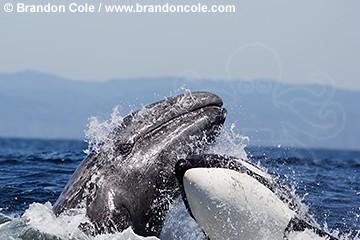|
photos of orca
(killer whales)
To see more killer whale
pictures, click here
|

orca whale breaching photograph available for licensing |

rare photo of gray whale calf being
attacked by transient killer whale |

stock picture of Pacific Northwest orcas showing dorsal fins |

killer whale marine digital photos speed-swimming (porpoising
behavior) |
|
common
name |
Orca,
or Killer Whale |
| scientific
name |
Orcinus
orca |
| range |
world-wide,
tropical to polar |
viewing
hotspots |
Washington
and Alaska USA, British Columbia Canada |
| habitat |
coastal,
open ocean |
| size |
to
30 feet (9m), 7 tons |
| diet |
salmon,
cetaceans, pinnipeds, sea birds, more |
| trivia |
technically a
dolphin; "Free Willy" movie star; adult male's dorsal fin is 6
feet tall; fast swimmer, up to 35mph |
|
Quite possibly one of the
most intelligent of all animals on the planet, the orca, Orcinus
orca, is the sea’s apex predator, infinitely capable, superbly
adapted. It is equally comfortable navigating leads through
Antarctica’s ice bergs as the open expanses of the tropical deep
blue. The largest member of the dolphin family, the unmistakable
black and white "killer whales" were once cursed as
rapacious killers and erroneously blamed for innumerable maritime
crimes. Thanks to extensive scientific study over the last 30 years
(much of the research conducted on the whale populations in
Washington and British Columbia), we now not only know of the orca’s
benign nature towards man but much about the inner workings of this
animal’s complex life.
It is a remarkably social animal, with
family members often spending their entire lives together, arranged
into multi-generation matrilineal groups normally numbering between
three and 30. Each pod has a rich repertoire of vocalizations
comprising a unique dialect. Sophisticated hunting strategies are
taught from parent to offspring, such as purposefully beaching
oneself on the beaches of Patagonia to capture pinnipeds or
delicately stealing fish off fishing lines.
Killer whales of the Pacific Northwest are
divided into three races. Resident pods, such as J, K, and L in WA's
San Juan Islands and southern Vancouver Island in British Columbia
Canada, return yearly during summer months to feed on the salmon
bound for their mainland spawning streams. "Transient" and
"offshore" races, sighted in the area from time to time,
are distinguished by subtle differences in fin shape, body markings,
and diet. Transients (and presumably offshores) feed primarily on
marine mammals such as seals, dolphins, and even other whales.
Life spans extend to some 80 years or more
for females, with 50 years average for males. Males grow to over 30
feet in length, with females averaging 20 feet. Calves are born
approximately 8 feet long, weighing 350 pounds.
|
|
| KEYWORDS
orca, orcas, killer whale, killer whales, killer, whale, whales, Orcinus
orca, cetacean, cetaceans, marine mammal, marine mammals, delphinidae,
toothed, breaching, jumping, spyhopping, underwater, behavior, photo,
photos, photograph, photographs, picture, pictures, stock, photography,
marine, attacking, killing, hunting, gray, grey, calf |
|